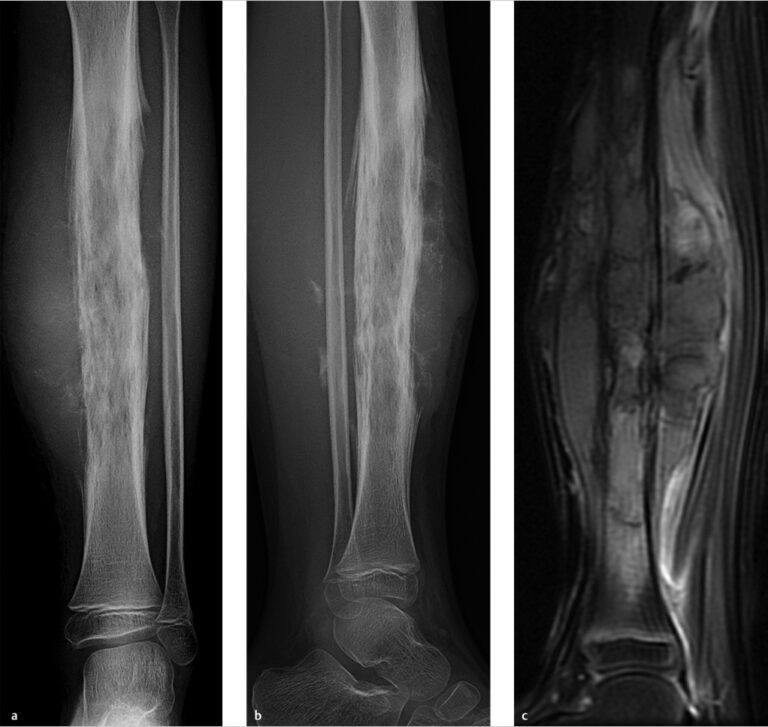Osteomyelitis and osteosarcoma are two distinct medical conditions that affect dogs. Osteomyelitis is a bone infection that commonly occurs due to an open wound or surgery, while osteosarcoma is an aggressive form of bone cancer.
While both conditions might present similar symptoms, such as limb pain and lameness, they require different treatment approaches. Therefore, prompt and accurate diagnosis is essential to ensure that the dog receives the appropriate medical care. This article will explore the differences between osteomyelitis and osteosarcoma in dogs, including their causes, symptoms, diagnosis, treatment options, and prognosis.
By the end of this article, readers will have a better understanding of each medical condition and how to identify them in their furry companions.

Credit: avmajournals.avma.org
Osteomyelitis In Dogs
Osteomyelitis is a severe infection of the bone marrow and bone in dogs. The condition occurs when bacteria invade the bone through the blood. Osteomyelitis in dogs can also occur if the bone is exposed to the environment or punctured.
The underlying causes of this condition include oral infections, surgical procedures, and bone fractures. Generally, symptoms of osteomyelitis include limping, pain, swelling, and fever. Veterinary diagnosis of this condition comprises blood tests and imaging tests. The treatment procedure involves the administration of antibiotics, surgical procedures to remove the infected bone, and pain management therapy.
Osteosarcoma, on the other hand, is a malignant bone tumor that often shows up in the limbs of dogs. Unlike osteomyelitis, osteosarcoma starts in the bone, spreads quickly, and can be fatal.
Osteosarcoma In Dogs
Osteosarcoma is a common bone cancer found in dogs and is primarily seen in large breeds. It is an aggressive and fast-spreading cancer that can potentially spread to other parts of the body. Osteosarcoma occurs when bone-producing cells start growing uncontrolled.
The causes are not yet known, but genetics may play a role. Symptoms include lameness, swelling, and pain at the site of the tumor. X-rays and biopsies are used to diagnose osteosarcoma. Early detection and treatment can help prolong a dog’s life, although recovery is not guaranteed.
Treatment options include amputation of the affected limb, chemotherapy, or a combination of both. Pain management is also an important aspect of treatment for osteosarcoma in dogs. It is important to detect osteosarcoma early to give your dog the best chance at recovery.
The Differences Between Osteomyelitis And Osteosarcoma In Dogs
Osteomyelitis and osteosarcoma are two distinct types of bone diseases that affect dogs. Osteomyelitis is an infection of the bone caused by bacteria that enter the dog’s body through an open wound or surgery site. Osteosarcoma, on the other hand, is a type of bone cancer that typically presents as a painful swelling on the affected bone.
The main differences between the two diseases are that osteomyelitis is caused by an infection while osteosarcoma is a type of cancer. Additionally, osteomyelitis tends to present with pus, swelling, and fever, while osteosarcoma typically presents as a painful mass that affects the dog’s mobility.
Veterinarians usually differentiate between the two diseases by conducting a physical exam, imaging studies, and a biopsy. Knowing the differences between osteomyelitis and osteosarcoma can help dog owners recognize symptoms and seek prompt veterinary care.
Treatment Of Osteomyelitis And Osteosarcoma In Dogs
Osteomyelitis and osteosarcoma are two distinct yet serious bone diseases in dogs that require different treatments. Medical treatments for osteomyelitis include antibiotics and pain relief medications, while surgical treatments may involve removing the infected bone or draining abscesses. For osteosarcoma, limb amputation followed by chemotherapy is the most effective treatment option.
However, osteosarcoma has a poor prognosis as it often metastasizes quickly and aggressively. On the other hand, the prognosis for osteomyelitis is generally more positive provided that the disease is caught early and the appropriate treatment is administered promptly. Ultimately, early detection and treatment are critical in improving outcomes for both osteomyelitis and osteosarcoma in dogs.
FAQFor Osteomyelitis Vs Osteosarcoma Dog
What Is Osteomyelitis In Dogs?
Osteomyelitis is an inflammation or infection of the bone that can affect dogs. It occurs when bacteria or fungi invade the bone, causing severe pain, swelling, fever, and lameness.
What Is Osteosarcoma In Dogs?
Osteosarcoma is a common, aggressive and malignant cancerous tumor of the bone that typically affects large dog breeds. It causes pain, swelling, and lameness, especially in the affected leg.
What Are The Symptoms Of Osteomyelitis?
The signs of osteomyelitis in dogs include limping, swelling, pain, decreased appetite, and fever. The affected area may also feel warm or tender to the touch.
What Are The Symptoms Of Osteosarcoma?
The symptoms of osteosarcoma in dogs can include swelling around the affected area, limping, pain, reluctance to put weight on the affected leg, and lethargy.
How Is Osteomyelitis Diagnosed In Dogs?
Osteomyelitis is diagnosed through a combination of physical examination, x-rays, and blood tests. Biopsies may also be performed to determine the type of bacteria or fungus that is causing the infection.
How Is Osteosarcoma Diagnosed In Dogs?
The diagnosis of osteosarcoma in dogs usually involves a combination of X-rays, ct scans, and biopsies. Blood tests may also be performed to determine the dog’s overall health and to check for any signs of spread to other areas of the body.
Conclusion
Dog owners need to be aware of the key differences between osteomyelitis and osteosarcoma when it comes to their furry friends’ well-being. While both conditions may provoke similar symptoms, such as pain and lameness, the causes and treatments are entirely different.
It’s crucial to work closely with a veterinarian to ensure an accurate diagnosis and appropriate care plan. In some cases, a combination of treatments may be necessary, such as surgery, antibiotics, and pain management. With prompt and effective treatment, dogs diagnosed with either osteomyelitis or osteosarcoma can often recover and resume their normal activities.
As a responsible pet owner, staying informed and advocating for the best possible treatment is essential in supporting our four-legged companions’ health and happiness throughout their lives.



